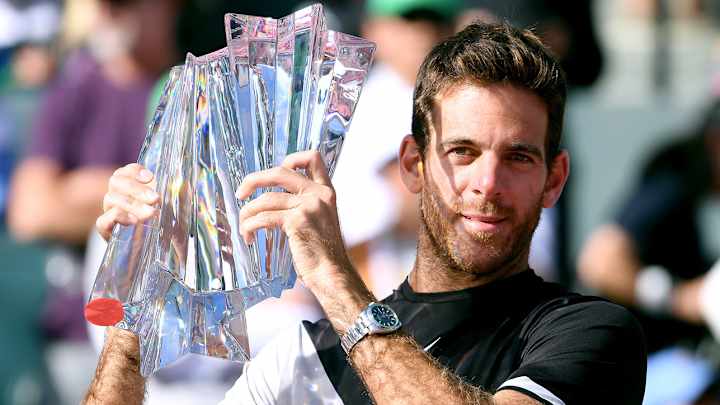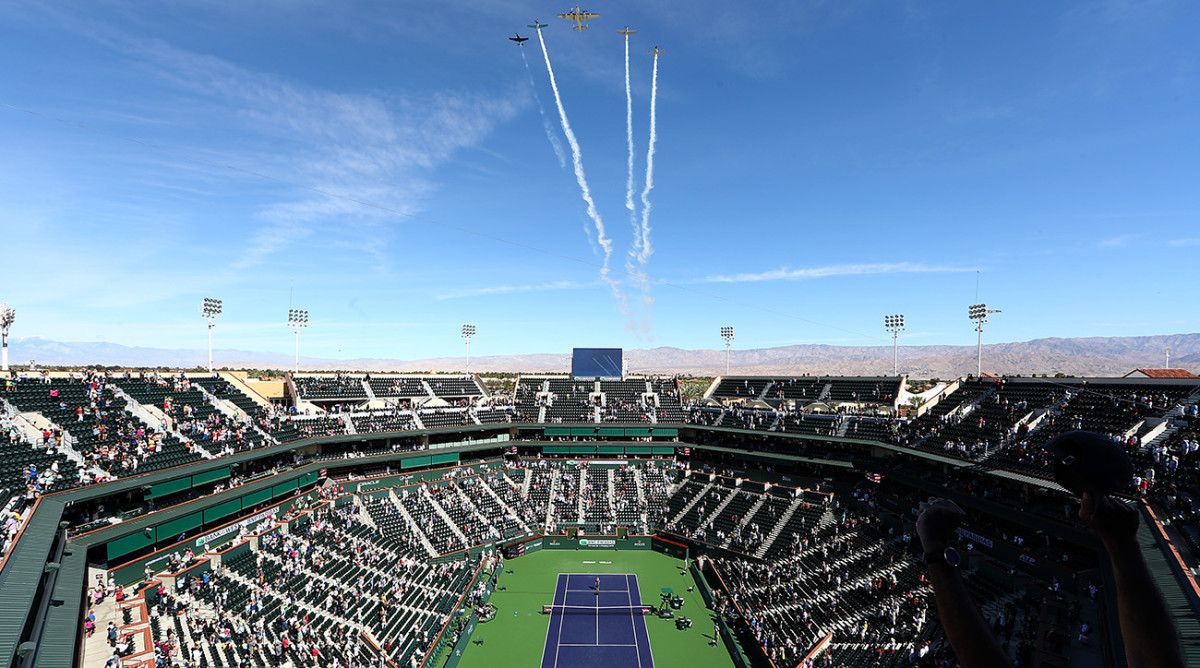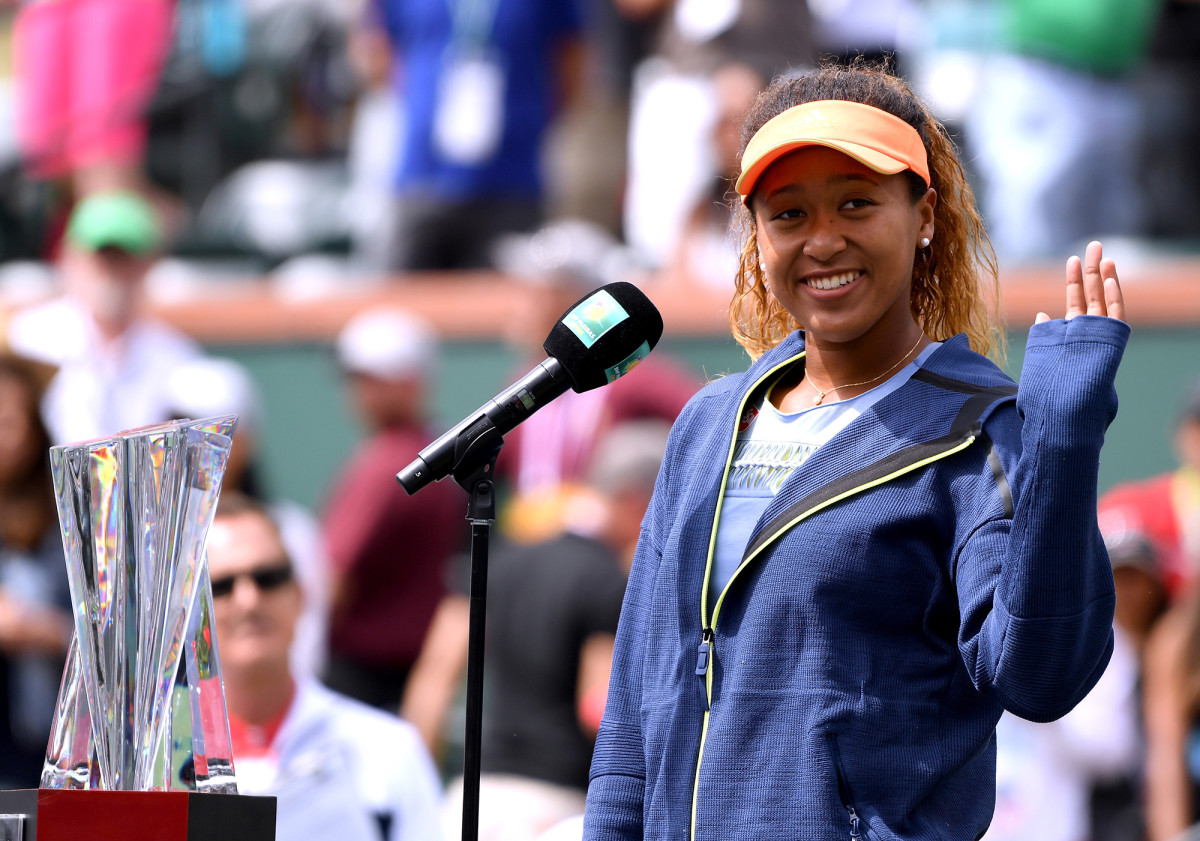40 Parting Thoughts from the 2018 BNP Paribas Open in Indian Wells

It's not technically a Grand Slam tournament, the BNP Paribas Open. But it's pretty close. After 12 days in the desert, herewith 40 thoughts—as opposed to our customary 50—from Indian Wells.
• Naomi Osaka has arrived. It’s that simple. Part Haitian, part American, part Japanese and wholly awesome, she won the women’s title beating all manner of opponent by hitting through them. She followed a demolition of top-ranked Simona Halep by routing Daria Kasatkina 6-3, 6-2 in the final for the biggest title of her career—for now, anyway.
• Early in the tournament, a coach who will go nameless claimed to me that there was only one player in the tournament who was unafraid of Roger Federer. He took my drawsheet and circled the name Juan Martin del Potro. Days later, DelPo wins the first Masters 1000 title of his career, taking down the Mighty Federer 6-4, 6-7(8), 7-6(2) in a splendid final.

• This loss in the final will sting. But Federer is the belt that is cinching men’s tennis (all of tennis?) right now. He’s reached an altitude to which no other player has ventured. And, at 36, he is playing some of the best tennis of his career. We can worry about the inevitable transition period that will exist after Federer retires. But for now, enjoy the history being made.
• Daria Kasatkina played a terrific tournament, winning with guile and winning with power; winning in heat and winning in chill; beating players she should beat and those (Carolina Wozniacki, Venus Williams) she perhaps should not. Pity she leaves on a sour note after a lop-sided final because, until then, she was terrific.
• John Isner and Jack Sock won the men’s doubles, beating Bob and Mike Bryan 7-6(4), 7-6(2) in the final.
• Su-Wei Hsieh and Barbora Strycova took the women’s beating top-ranked Ekaterina Makarova and Elena Vesnina, 6-4, 6-4.
• Two weeks of Roger Federer and the super-excellent men’s final masked this inconvenient truth: The top five seeds from 2017—Andy Murray, Novak Djokovic, Stan Wawrinka, Rafael Nadal and Kei Nishikori—won zero matches in Indian Wells in 2018. Injuries are no joke.
• Venus Williams has not won a title since 2016, but, overall, she’s played some terrific tennis over the past 18 months. Give her the right set of circumstances and this is no farewell tour she’s on.
• Serena Williams did herself proud in return from maternity leave, winning two matches against quality opponents and then falling to Venus in the 29th intra-family battle. Food for thought: if Serena had won this tournament, might it, perversely, have dented her legacy? Had she retuned after 404 days of absence that included childbirth, shown up (understandably) in sub-optimal shape, and taken the trophy, would people not have said, “She has no competition! What does it say about the field that they can’t storm right back like that?” Instead, Serena’s loss suggests that, in the past, the field has been good. She’s simply been better.
• A few of you asked what Serena needs to improve. The obvious answer: her serve. Against Venus she won barely half of her points on serve. She also needs to play herself back into shape. But she ought to be encouraged overall. What was obvious to all: “She’s not there yet, but she ain’t far off.”
• If Serena’s returned answered doubts, the return of another double-digit-Slam winner stoked doubts. Novak Djokovic, a five-time champ here, lost his first match to No. 109 Taro Daniel, capitulating 6-1 in the third set. Nerves played a role. Djokovic’s game was pocked by errors, especially to the backhand, that were uncharacteristic and inexplicable. It was as if Djokovic were playing his first match. And that’s *his* assessment. As I write this, Djokovic is still entered in Miami but perhaps he’d be well served to head back to Monte Carlo, regroup, and rebound on the clay.
• The Rafael Nadal update: he’s at home resting his psoas injury. And we mean resting. He can’t run or golf or fish. He plans to play Davis Cup and then get going on the clay.
• Top of the cap for tournament director, Tommy Haas, who officially became an ATP pensioner last week. While the retirement of 39-year-old athlete—who now must wear long pants to his administrative job—is not exactly a news flash, let the record reflect: Haas is one of only five players to have beaten Federer in the last year.

• Maria Sharapova lost to Naomi Osaka, her third straight defeat. Like so many of her shots, Sharapova simply looked wayward. She didn’t move well. Her balls lacked depth. She didn’t serve well. She may have been dealing with a nagging injury. One of our favorite refrains: tennis careers are not linear functions. That said, you suspect that Sharapova did not expect that her first year back from the doping suspension would be nearly this rocky. After the match she and coach Sven Groeneveld—who remained on the team throughout the 16-month doping suspension—parted ways. Further indication of strange times on Republic of Sharapova.
• This is unpleasant, but here’s a truism of sports: when players return from a doping suspension they are freighted with the additional weight of trying to prove that their previous success did not come on account of cheating. (Anyone who shares my guilty pleasure for MMA knows how often fighters mention this.) It’s hard (dishonest even?) to talk about Sharapova’s comeback and not mention this dimension. Yes, she is playing to restart her career and spin the plot forward. But she is also playing to preserve the past, to validate what came before the suspension. That’s an immense burden to bear.
• I had the good fortune of spending some time with Simona Halep before the event. We’ll do a longer Q/A prior to the French Open. But there is a commendable what-you-see-is-what-you-get to her. Though she’s from Romania, she strikes me as very Midwest. Grounded. Self-reliant. Rigorously honest. No drama. No movie star ambitions. No double talk. She knows she needs to win a major to certify herself. She knows it and she knows she can do it.
• We don't talk much about fashion…who wears what kit and whose dresses and shirts are flattering or unflattering. But a Hall of Famer made this strong point, which is material to tennis. When a player takes the court for a match here—a Grand Slam–caliber event—looking like she just got out of bed, wearing a mismatched outfit and an ill-fitting top, it’s a “tell” to the opponent. That is, she is revealing plenty about her confidence level and her lack of executive function.
• Related topic and take this for what it’s worth…but for the Tennis Channel pregame show, we had a fairly early call time so I was often on-site at 7:00 or 7:30 a.m. The two players I saw most often at that early hour, looking awake and headed to the practice courts: Carolina Garcia and Venus Williams.
• The great unspoken about Indian Wells: the gushing and flattery is completely deserved. It truly is an exceptional sporting event in every respect. But it is not operating under the same economic model and P/L pressures as other events.
• One example among many: it is the rare tournament that, on the eve of the tournament—without buying insurance, I’m told—can add a $1 million bonus for a player winning both singles or doubles. As it turned out no player earned the bonus. Here's hoping we roll it over, Newman-style, and make it $2 million in 2019. For the record, Sam Querrey was the last man to remain eligible.
• By reaching the quarterfinals round, Hyeon Chung overtakes Kei Nishikori as the highest-ranked Asian male. Stop and applaud Nishikori for his longevity. And consider that with Nishikori, Chung (and Naomi Osaka) in the field, tennis ought to get some nice run at the 2020 Tokyo Olympics.
• Genie Bouchard received a wild card and lost (badly) to Sachia Vickery in round one. We’re long accustomed to players whose profile and popularity and marketing muscle eclipse their on court accomplishments—there’s no rule that popularity ranking must correspond to computer rankings. But Bouchard is well outside the top 100 and eventually these wild cards are going to run out—and so, it seems, are the sponsorships. She got paid by the Bank of White Plains, but the bottom line is that she needs to start winning matches.
• Hard to recall a junior transitioning to the pros more smoothly than Amanda Anisimova has. The 16-year-old from New Jersey won three matches—including a rock-em, sock-em defeat of Petra Kvitova—and will be in the top 150. She has plenty assets but it’s her lacks that might be more impressive. She is completely devoid of awe. You have the feeling she is exactly where she expects to be and no success is surprising to her.
• Long known as Serena’s hitting partner, Sascha Bajin has made a nice transition to coach. He’s now working with Naomi Osaka and has learned that sometimes his duties extend far beyond forehands and backhands. In Osaka’s third-round match, Bajin had to deal with a heckler in the opposing camp who was upsetting his player.
• Taylor Fritz has added the wise head of Paul Annacone to the brain trust. After an eventful stretch—that included becoming a father and dealing with a vexing injury—Fritz is back in the top 75 and arrowing upward. His third round win over Fernando Verdasco—a 7-6 in the third, who-wants-it-more? special—was a vital step Fritz’s evolution.
• R.I.P. Ken Flach.
• Flach played at Southern Illinois, coached at Vanderbilt and was a champion for college tennis…which continues to re-emerge as an advisable option for so many. Add Danielle Collins to the list. The two-time NCAA champion (and graduate) at the University of Virginia had a career breakthrough here beating a sluggish Madison Keys and reaching round four.
• One of the open secrets of tennis: when a management agency owns an event, it uses its discretion over wild cards to the benefit of the players it represents—and uses it as a recruiting sweetener. “Sign with us and we’ll promise you a main draw wild card into the X event.” So it is the IMG-owned Miami Open is flush with IMG clients. Fine. But it’s a bad look when players like No. 360–ranked Mikael Ymer is getting an automatic in to a Masters 1000 event while Frances Tiafoe—No. 64, bright American prospect, winner of an event 30 miles up the road just last month—was denied.
On Thursday, Tiafoe landed in the main draw when Pablo Cuevas withdrew with injury. But I’d argue there’s a good-of-the-sport moral imperative here. This is just a bad look all-around.
• A few of you asked about Sloane Stephens, who looked terrific against Victoria Azarenka and then looked something considerably less than terrific against Daria Kasatkina. My take? Sloane likes tennis but she doesn’t love it. And, as such, her play will always fluctuate.
• I had to leave Indian Wells a few days early to get to New York. The United Airlines gates might as well have been an annex to the players lounge. Sascha Zverev, Tomas Berdych, Dominika Cibulkova. One day you’re a Grand Slam finalist, the next day you’re just another weary traveler trying to figure out your boarding zone. The fate of the individual sport athlete…
• Story to follow: an ATP board seat for a European representative on the player’s side will come open soon. This is a critical vacancy.
• How young is Felix Auger Aliassime? When he was born, both Serena and Venus had already won majors. How good is Felix? Very.
• Were it not for Lucie Safarova’s illness, Bethanie Mattek-Sands would have been ready to play doubles here. The miracles of modern medicine….
• It will be interesting to see if Indian Wells and Miami follow the Grand Slams and reduce the seeds to 16. As it is, 32 seeded-players in a 96-player draw is a lot.
• One of the revelations of the tournament: Caroline Dolehide, a 19-year-old from Illinois who took a wild card and justified it, playing with fearlessness and showing some real variety. She won two matches and then took a set off of Simona Halep. Well done.
• Non-tennis (sort of) but this first person piece by Steve Francis has been in heavy rotation in my world. I was struck by this passage about the end of his career: “I went from selling drugs on the corners in D.C. to the NBA in four years…and now it’s over? It’s a wrap? At 32? I knew it was the end, and that’s some really, really hard s*** to swallow. I don’t care who you are....It took me damn near four years to really accept that I wasn’t gonna play ball anymore. That it was really over. I had some dark days, no question. And I know people were asking, ‘What the hell happened to Steve Francis?’”
We often wonder in tennis why so many players—Marion Bartoli and Vera Zvonareva are new additions—come out of retirement. Francis provides some insight. It’s tough to be in your early 30s when you’re time is up and you’re facing a lot of anticlimax.
• The ultimate draw would have been Federer (or Williams-Williams) and that didn’t happen. But note how many top singles players also entered doubles here. Simona Halep, Dominic Thiem, Grigor Dimitrov, Karolina Pliskova, Victoria Azarenka and Juan Martin del Potro were among those taking a shot at the $1 million singles/doubles bonus.
• We hear that Victoria Azarenka’s custody battle is still a work in progress. But “progress” is an operative phrase. As we write this, she is entered in Miami. We’ll see whether she adds international events to her schedule. A second-round loser here (to Sloane Stephens), Azarenka is 28 and this was just her third event in the last 20 months. We’ve seen (far too) many players miss prime years with injury. But it’s hard to recall a player missing prime years by choice. In this respect, she is to be commended.
• Dave Haggerty, ITF president, spent time at the event explaining the Davis Cup reform proposal and clearing up misconceptions. He joined the SI/Tennis Channel podcast and made his case. No question there are many questions left unanswered. (And the notion that fans will flock in droves to Singapore is—how to put this?—a serious yoga stretch.) But from the “innovate or die” playbook, I don’t see how federations vote this down.
• Thanks for your Tennis Channel mail and know it gets read and passed on when appropriate. Here’s a good rule of thumb that will perhaps clear up confusion. If there’s a big event, odds are good that TC will come on at 10:00 a.m. local with a pregame show (earlier at the U.S. Open) and then pivot to calling matches, which usually start at 11 a.m.
